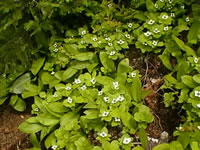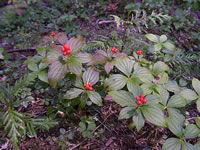How to Grow and Care for Creeping Dogwood & Bunchberry Plants
Cornus Canadensis
       
Bunchberry Dogwoods are probably the ultimate ground cover plants for growing in moist,
woodland areas or in your shade garden.
These short, bright green plants only reach six inches tall,
but they spread indefinately by rhizomes just below the soil surface.
From early May through September, they produce typical Dogwood blossoms
which consist of a cluster of tiny greenish flowers surrounded by four creamy white bracts.
In late summer, the flowers are replaced by clusters of bright red, edible berries that are a food staple
for many species of wild birds and other wildlife.
In the fall, the shiny, deeply veined foliage turns to a beautiful burgundy-red.
|

|
Growing Requirements for Creeping Dogwood Plants
Creeping Dogwood plants are hardy in zones 2-8
Unfortunately, Bunchberry plants are pretty fussy about where they will grow, but they are well worth the effort it takes to help them thrive.
They will tolerate morning sun, but should be grown in partial to full shade for the best results.
Creeping Dogwoods demand a loose, moisture retaining, humus rich soil, so add lots of compost and peat moss to the planting hole.
They will not tolerate alkaline soil at all, requiring a soil pH of 6.8 or lower.
These are very heat sensitive plants that will wither and die if soil temperatures exceed 65°, or if the soil ever dries out completely.
|
|
A heavy mulching with peat moss or pine needles will help the soil retain moisture and keep it cooler.
Water regularly and thoroughly during dry periods.
Propagating Bunchberry Plants and Growing them from Seed
Bunchberries can be propagated by cuttings taken just below the soil surface in mid summer.
Strike in a moist, 50/50 mix of sand and peat moss.
Bunchberry seeds can be planted ¾" deep in the garden in the fall.
The seeds require a period of stratification for germination, so if you are starting them indoors, store them in moistened peat moss in your refrigerator for three month prior to sowing into flats or pots.
Unfortunately, germination can take two or three years. |
|
Bunchberry
Cornus canadensis

|

|
|
|
|
|
Search The Garden Helper:


